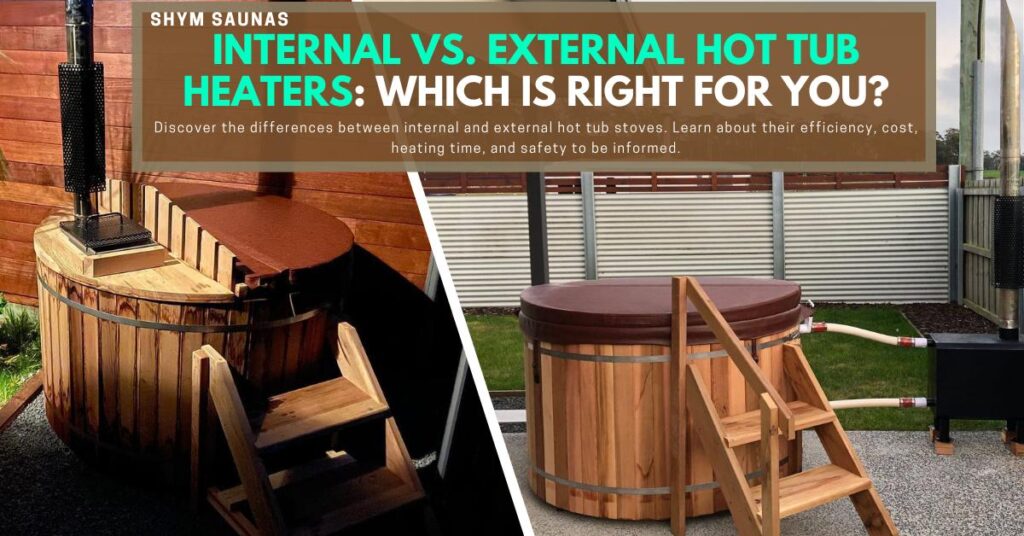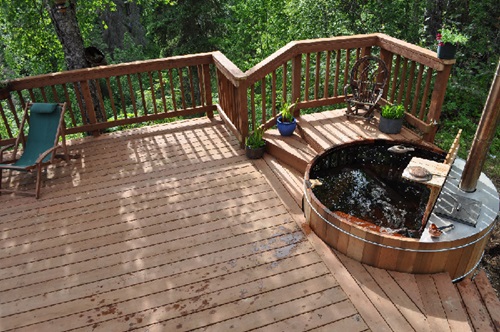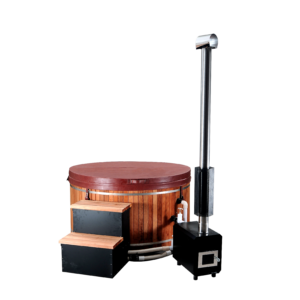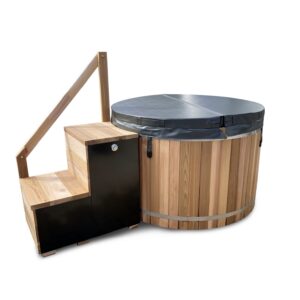Internal vs. External Hot Tub Stoves: Which Is Right for You?

When considering the heating options for a log burner hot tub, the debate often centers around whether to opt for an internal or external stove. Each type presents its own set of advantages and disadvantages, affecting everything from heating efficiency to the amount of space available for bathers.
In this post, we’ll delve into the key differences between internal and external hot tub stoves, including aspects such as heating time, cost, space requirements, efficiency, maintenance, and safety considerations for.
Key takeaways
- Internal stoves heat the water more quickly due to their direct contact but take up valuable space inside the tub, limiting the number of users.
- External stoves, while heating more slowly, enhance safety and ease of maintenance, and do not reduce the capacity for bathers inside the tub.
Why Still Use Wood Heaters in 2024?

Wood heaters remain a popular choice for many due to their cost-effectiveness, efficiency, and sustainability. Wood heating can be a viable and economical option, particularly in regions where wood is plentiful and inexpensive. Wood heaters provide a consistent and robust heat source, making them ideal for maintaining comfortable temperatures during cold weather.
They are also a renewable energy source, reducing dependence on fossil fuels and minimizing carbon footprints. Additionally, advancements in wood heater technology have significantly improved their efficiency and safety, making them a reliable choice for modern heating needs. Read more about the facts and figures of wood heating on this article from Penn State Extension.
Internal and External Hot Tub Heater Comparison
Internal stoves, typically more budget-friendly and quick to heat, immerse directly in the water, taking up more space but offering efficient heat transfer. On the flip side, external stoves, while requiring more setup space and longer to heat, are user-friendly, easier to clean, and eliminate burn risks for children by being positioned outside the tub.
Whether you prioritize cost, space, efficiency, or safety, understanding these differences can guide you to the best choice for your wood-fired hot tub needs.
| Internal Hot Tub Heater | External Hot Tub Heater | |
| Efficiency | Faster heating due to direct contact with water | Can heat large volumes efficiently with the right power |
| Heating Time | Generally heats water faster | Takes longer to heat water |
| Energy Efficiency | Highly efficient with minimal heat loss | Less efficient due to heat loss to the atmosphere |
| Operational Costs | Typically lower | Can be higher due to longer heating times |
| Space Considerations | Reduces available space for bathers | Requires additional space outside the tub |
| Safety | Requires careful handling to avoid burns | Reduces burn risk as heating element is away from bathers |
| Maintenance | Harder to maintain | Easier to clean and maintain due to accessibility |
| Suitability for Families | May not be ideal due to space and safety concerns | Better for households with young children due to reduced burn risk |
1. Heating Time and Efficiency
The efficiency of heating water in a hot tub is a critical factor for many users. Internal stoves offer faster heating due to their direct contact with the water, but external stoves, with the right power, can also heat large volumes of water efficiently. The choice between the two often comes down to balancing heating time with energy efficiency and operational costs.
2. Space Considerations
If space is a premium, internal stoves might not be the best choice, despite their efficiency. They reduce the amount of available space for bathers, which could be a significant downside for those who frequently host friends or family. On the other hand, external stoves require additional space outside the tub but leave the interior completely open for users.
3. Safety and Maintenance
Safety is paramount, especially in households with young children. External stoves significantly reduce the risk of burn injuries, as the heating element is located away from the bathers. They are also easier to clean and maintain, given their accessibility. Internal stoves, while efficient, require careful handling to avoid accidents and can be more challenging to maintain over time.
Why Choose Internal Hot Tub Stoves?

Internal stoves are placed directly inside the hot tub, making them a compact option if you’re looking to maximize the heat transfer from the firebox to the water. This direct contact means the water can heat up relatively quickly, typically within 2 to 4 hours, depending on the stove’s power and the volume of water.
However, they take up significant space inside the hot tub, which could limit the number of people who can enjoy the tub at once. While they boast high efficiency due to 100% of the heat transferring directly into the water, internal stoves are less convenient to clean and pose a higher risk of burns, as the heating element is accessible to bathers.
This design brings several advantages and some drawbacks:
1. Efficiency
Internal stoves are known for their high efficiency because they transfer nearly all the generated heat directly into the water. This direct contact means that the heating process is maximized, reducing energy loss. Consequently, these stoves can heat the water more quickly compared to external stoves.
2. Cost and Availability
Generally, internal stoves are less expensive than external ones, depending on the model. The simplicity of their design and installation process often translates to lower upfront costs.
However, the options for internal heaters are more limited, with fewer brands manufacturing these models. They are primarily chosen for specific types of hot tubs, especially those where space and aesthetic integration are less of a concern.
Internal heaters are less commonly found in retail outlets and may require special ordering or direct purchases from manufacturers.
3. Heating Time
Due to their placement within the water, internal stoves heat the water faster. Typically, they can bring the water to a comfortable temperature within 2-4 hours, depending on the stove’s power and the volume of water.
4. Space Considerations
One significant drawback of internal stoves is that they occupy space inside the hot tub. This can reduce the number of people the tub can accommodate. For example, a hot tub designed for six people might only comfortably fit four when an internal stove is installed.
5. Safety
Internal stoves tend to be safer in terms of burn risk because they are submerged in water and often fenced off from bathers with a dedicated separation fence. This design minimizes the risk of accidental burns, making it a safer option for families with children.
Installation Idea: Recessed Installations

One significant advantage of internal hot tub stoves is their suitability for recessed installations. If you plan to install your tub into a deck or floor, an internal heater is a better option. External heaters require access from underneath the floor, which can be inconvenient.
Internal stoves, placed directly inside the tub, allow for easy access and maintenance without the need to reach under the floor. This makes them a practical and convenient choice for installations that are recessed, ensuring a seamless and hassle-free experience.
What are External Hot Tub Stoves?

External stoves sit outside the hot tub, connected via heat-resistant hoses that circulate water through the heater to warm it up. This setup is easier to clean and safer, particularly for families with children, as the hot surfaces are kept out of reach.
Though external stoves require more time to heat the water, typically over 4 hours, they don’t intrude on the bathing space, allowing for more occupants in the tub. The primary drawback is that some of the heat escapes to the atmosphere, making them less efficient than internal models. However, they compensate with greater ease of use and maintenance, alongside enhanced safety features.
-
 Outdoor Cedar or Thermowood Hot Tub With External Firewood Heater and Cover$5,200.00 – $9,100.00
Outdoor Cedar or Thermowood Hot Tub With External Firewood Heater and Cover$5,200.00 – $9,100.00 -
 Outdoor Cedar Hot Tub With External Firewood Heater, Pump, Filtration System and Cover$7,200.00 – $8,200.00
Outdoor Cedar Hot Tub With External Firewood Heater, Pump, Filtration System and Cover$7,200.00 – $8,200.00
External Hot Tub stoves offer different benefits and challenges:
1. Ease of Use
External stoves are generally easier to access for lighting and cleaning. Because they are outside the tub, maintenance tasks such as ash removal and fire lighting are more straightforward and less intrusive.
2. Space
By being located outside the tub, external stoves do not take up valuable space within the hot tub itself. This means that the full seating capacity of the hot tub is available for users. This feature is particularly beneficial for larger gatherings or when maximum seating is a priority.
3. Safety
While external stoves are convenient, they do pose a higher risk of burns. Since the stove and its chimney are accessible, there is a risk of accidental contact, especially for children playing nearby. It is essential to install proper safety measures, such as barriers or guards, to prevent injuries.
4. Variety and Availability
There are numerous external heaters available on the market, offering different sizes, power levels, and functionalities. This diversity allows users to choose a model that best fits their specific requirements.
These heaters are commonly stocked by many retailers and online stores, making them easy to purchase and replace if necessary.
5. Heating Time
External stoves generally take longer to heat the water, typically requiring 4 or more hours. The reason for this extended heating time is the heat loss that occurs as the heat travels from the stove to the tub through the hoses.
6. Efficiency
External stoves are less efficient than internal stoves. Heat is lost to the atmosphere as it travels from the stove to the hot tub, resulting in a less efficient heating process. This means that it can take more fuel and time to reach the desired water temperature.
How about Hot tub with Electric Heaters?
-
 Outdoor Cedar Hot Tub With Electric Heater, Pump, Filtration System and Cover$7,700.00 – $9,600.00
Outdoor Cedar Hot Tub With Electric Heater, Pump, Filtration System and Cover$7,700.00 – $9,600.00
While log burner hot tubs provide a rustic, off-grid experience with their quick heating and natural ambiance, electric heaters excel in consistency, ease of use, and safety. Ideal for those who prefer low-maintenance and precise temperature control, electric heaters ensure a hassle-free soaking experience without the need for firewood or managing a flame.
Heating Efficiency
Electric heaters offer consistent and reliable heating for hot tubs. They typically heat water more slowly than wood-fired stoves but maintain a steady temperature once the desired heat level is reached.
Space
Electric heaters are usually compact and do not take up space inside the hot tub. This allows for maximum bather capacity without compromising comfort.
Installation
Installation of electric heaters is generally straightforward and does not require venting, unlike wood-fired stoves. This makes them a versatile option for various setups, including indoor and recessed installations.
Maintenance
Electric heaters are low-maintenance compared to wood-fired stoves. They do not produce ash or soot, reducing the frequency of cleaning. Additionally, they offer safety advantages as there is no open flame or hot surfaces accessible to bathers.
Safety
Electric heaters are safer, especially for families with children, as there are no risks of burns from open flames or hot metal surfaces. Built-in safety features often include automatic shut-off mechanisms and temperature controls to prevent overheating.
General Tips for Hot Tub Heaters

When considering hot tub heaters, whether internal or external, here are some essential tips to ensure optimal performance, longevity, and safety:
Use a Quality Cover
A high-quality hot tub cover helps retain heat and keep debris out of the water. Ensure it fits well and is in good condition.
Insulate the Hot Tub
Proper insulation helps maintain water temperature and reduces energy consumption. Consider adding additional insulation to the cabinet or using a thermal spa blanket.
Regular Filter Cleaning
Clean the hot tub filter weekly or more often with heavy use. A clean filter ensures efficient water flow and prevents debris from reaching the heater.
Annual Heater Inspection and Professional Maintenance
Schedule an annual inspection with a certified technician to check the heater’s electrical connections, thermostat, and heating elements. This proactive approach helps identify potential issues early. Get help from your heater supplier or manufacturer.
If you are not comfortable with maintenance tasks or have no time (this is especially a great tip for business owners), hire a professional. Certified technicians can perform thorough inspections and maintenance, ensuring the heater operates efficiently and safely.
Winter Protection
In colder climates, protect your hot tub heater from freezing temperatures. Drain the tub and store the heater in a dry place, or run the tub at a low temperature to prevent freezing if it can’t be drained.
Ensure Adequate Water Flow
Make sure there are no blockages in the water circulation system to maintain proper water flow through the heater. This prevents overheating and ensures efficient heating.
This also is applicable after cleaning or refilling, ensuring there are no air pockets in the plumbing, as these can affect water flow and heating efficiency.
Energy Efficiency
Consider the energy efficiency of your hot tub heater. Models like the SunHeater S240U, Pentair MasterTemp, and Hayward HeatPro are known for their efficiency and can help reduce energy costs.
Compatibility
When replacing or upgrading your heater, ensure it is compatible with your existing hot tub system. Check the power, voltage requirements, and physical dimensions to avoid installation issues.
Safety Precautions
Always turn off the power at the breaker box before performing any maintenance or repairs. Use a multimeter to confirm the power is off to avoid electrical shock.
Conclusion
Now it’s time to decide which type of hot tub heater suits your needs best. If you are limited on space, an internal heater is an excellent consideration. However, for larger families, especially those with young children, an external heater is a better choice. External heaters provide more space within the hot tub, reduce the risk of burn injuries, and are easier to clean and maintain.
Additionally, the greater variety and availability of external heaters on the market offer more flexibility in finding the perfect model to suit your needs.
Choose wisely to ensure your hot tub experience is both safe and enjoyable for everyone. For a wide range of hot tub heaters, complete hot tub kits, and other hot tub, sauna, and spa accessories, visit Shym Saunas to explore your options and make the best choice for your relaxation and wellness needs.
FAQs
Is a heater placed inside the tub more efficient than an external heater?
Yes, internal heaters are generally more efficient because they transfer almost all the heat directly to the water.
Which type of stove heats water faster?
Internal stoves usually heat water faster due to direct heat transfer, but both can heat quickly depending on their power and water volume.
What is the main difference between internal and external hot tub stoves?
Internal hot tub stoves are placed directly inside the hot tub, heating the water around them, while external stoves are situated outside the tub, with a system that circulates water to heat it up.
Can I install an external hot tub stove on an existing hot tub?
Yes, you can add an external stove to most existing hot tubs. You might need additional plumbing to connect the stove and ensure proper water circulation.
What are the safety considerations for internal and external hot tub stoves?
For internal stoves, ensure there’s a protective barrier to prevent burns. For external stoves, keep the area around the stove clear of flammable materials and ensure proper ventilation.



